2001.09.15 09:14
"incredible" military relic
Over a week or two ago I began planning a set of pages for Quondam that were to be entitled "the most incredible building of the 20th century." At the southern-most tip of the State of New Jersey, Cape May Point, there is a long abandoned World War II military bunker. When built, this bunker was 700 feet inland, but today "stands" about fifty feet out at sea. The coast there has shrunk, and the bunker is now very much an example of the Le Corbusian paradigm of a box elevated on pilotis. The bunker at Cape May Point is an enormous concrete hulk seemingly precariously poised on abundant tree-trunk pylons.
Besides the obvious, what I find incredible about this building is its concentration of symbolism and message:
  
1. that it is literally a concrete manifestation of it's time, namely the middle of the 20th century during World War II.
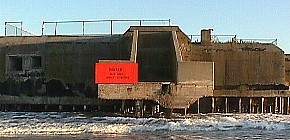
2. that it is (or at least was) a prime example of modern 'fortress' architecture.
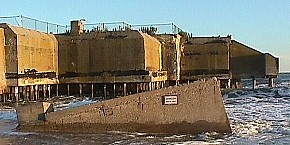
3. that it was once stealth, but over time has been explosed via the power of nature.
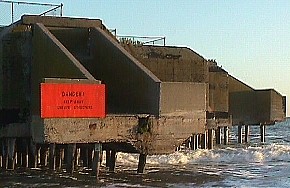
4. that it unwittingly now manifests exactly Le Corbusier's prime architectural theory for the 20th century, again the box raised on pilotis.
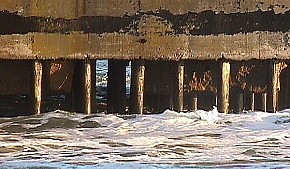
5. that it is now unsafe, inaccessible, and for all intents and purposes un-usable. Moreover, its future is uncertain, and may one day suddenly collapse.
In light of the recent sad, sad fate of the World Trade Center Towers, I think the bunker at Cape May Point will have to take second place when it comes to "the most incredible building of the 20th century."
| |
2001.10.04 08:38
reenactment and its [un]limits
On 17 February 2000 BC posed the following question to Lauf:
I wonder what the limits of reenactment are... ...where does reenactionary architecture begin and end?
On 18 February 2000 Lauf posted the following reply:
It seems logical that no reenactment occurs without an enactment occurring first... ...reenactment's most inescapable limit is that it can never be as original as that which it reenacts.
I remember feeling thankful to BC for having raised such a succinct question, because it provided the opportunity for me to verbalize what I believe to be an axiomatic aspect of reenactment.
This exchange came to mind when I viewed the "virtual re-creation [via laser light] of the [WTC] towers" as proposed by NY architects Gustavo Bonevardi and John Bennett--here reenactment seems to better describe what the proposal would actually be doing if it was indeed acted upon. This proposal also demonstrates the range of reenactment in that it (the range) comprises multiple degrees of separation from that which is reenacted, with the 'virtual re-creation' here being much removed from the original.
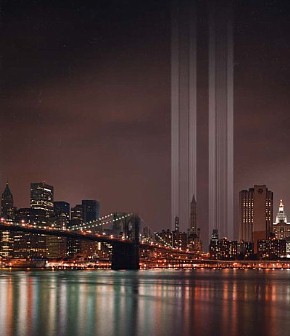
John Bennett, Gustavo Bonevardi, Julian LaVerdiere, and Paul Myoda, Towers of Light, 2001.09.17, Courtesy of Creative Time.
After thinking this through, I then realized that last week's hoax image of the tourist standing atop the World Trade Center just before the plane struck the Tower was also a reenactment, and perhaps even the closest reenactment of the very beginning of the horrible events September 11. Recall how Gregory Wharton very quickly pointed out all the degrees of separation that distanced the reenacting image from the 'original', while JY pointed out all the degrees of the reenacting image that set it close to the 'original'. That this image received national attention perhaps offers a prime example of just how much a reenactment can be real precisely when everyone knows the reenactment really isn't real.
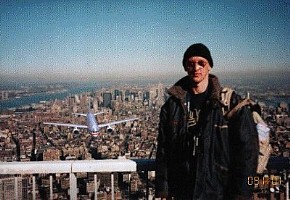
Anonymous, from a camera found onsite, 2001.09.26.
Strange how reenactments can be both real and unreal at the same time.
| |
2002.01.10 19:49
Re: agree, but
Regarding civic involvement I'll try to answer this way. When reading about the ancient Roman Triumphs, it is always noted that the whole city shut down, and all the population went to stand along the route of the Triumph parade to watch. I was initially skeptical of this, especially the notion of a whole city shutting down, and everyone going to see a single event. Maybe it did happen then, but it seemed hard to believe that something like that could happen in modern times. Diana's funeral changed my 'perception' of this.
Yes, as I write this, I realize that there are indeed several such occasions to be noted in modern time, the JFK funeral for example.
Quickly, the other details reenacted are:
-- Diana's coffin drove through several arches, one of which was indeed a Triumphal arch.
-- four real Princes accompanied the procession.
-- the 'spoils' of Diana's work were present in all the representatives of her charities that walked in the procession behind the Princes.
-- the route of the coffin passed numerous military monuments, of which at least one represented a tableau of soldiers, much like the battle tableaux that were part of the ancient Triumph parade (the precursor I'm sure of today's parade floats).
-- the procession ended at Westminster Abbey, what one can easily refer to as the most sacred place in London; the ancient Triumph ended at the Temple of Jupiter, the most sacred place in ancient Rome.
As I'm writing this I'm reminded of the movie A Special Day (I think that's the title). It starred M. Mastrioni and S. Loren, and the day was in Rome when Hitler came to visit Mussolini (two grim reenactors if there ever were any). All of Rome went to see the parade, and Mastrioni and Loren found themselves to be the only people in their apartment building, and the story of the movie goes on from there. Maybe when you see something in a movie it still feels just a bit unreal, just a play reenactment. Maybe what struck me so much about Diana's funeral is that it was just like a movie, but indeed real.
ps
John Young just coined the term "exenactments". I wonder if some events that immediately remind one of a movie but are indeed real could be called exenactments. Events like September 11 maybe?
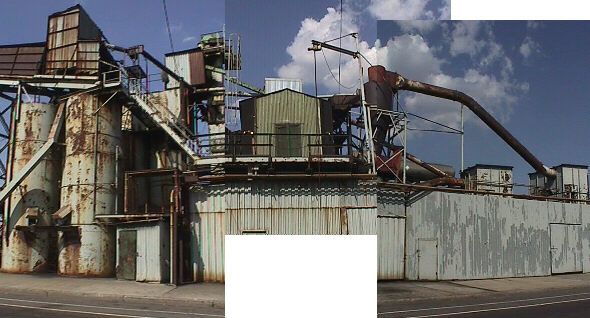
2002.01.11
Quondamopolis 001
QUONDAMOPOLIS comprises those places that are within Quondam's image collection but no longer exist. Quondamopolis 001 was demolished sometime between 29 July 1999 and 19 March 2001.
| |
2002.01.11 14:21
see the UNITED STATES
Even in all its decaying glory, the SS UNITED STATES is nonetheless the most impressive feature of Philadelphia's waterfront today.
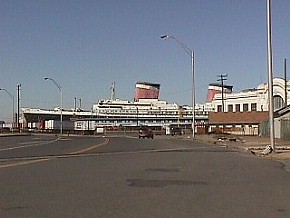 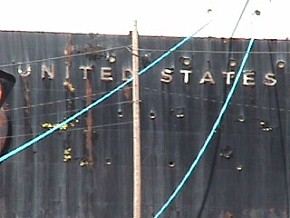 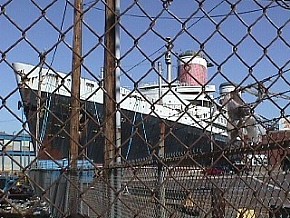 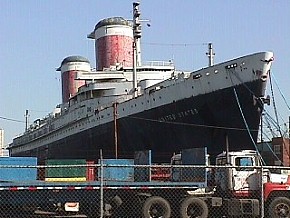
There is also www.ss-united-states.com.
I saw the SS UNITED STATES yesterday while taking my brother to see it for what was his first time in 47 years. Otto and my parents came to the United States on the United States. The images at Quondam are from 19 March 2001.
| |
2002.01.16 12:41
Period Rooms of the World Unite
It's odd to think how "culturally" rich modern Greece would be if all the art of ancient Greece were returned to its original site(s). Of course, much of ancient Greece is now modern Turkey as well, just like much of Byzantine Greece is now modern Turkey. Sure it would be nice (for some) if Hagia Sophia were once again a Christian house of worship (as it originally was) rather than the mosque-turned-museum it is now.
There are equally great pedimental ancient Greek sculptures (though not as famous as the Elgin Marbles) in Munich, Germany, and don't forget the altar of Pergammom in Berlin, which I think is in the same museum as the Gate of Babylon. Let's here it for returning this Gate to Iraq.
Maybe it's time for someone to do a great study on architecture that has moved and perhaps really hasn't stopped moving.
At Ryerss Museum in Burholme, Philadelphia there are the entire contents of a Buddhist Temple purchased pretty much as travel souvenirs by wealthy Americans almost 100 years ago. Again, where is that study on architecture that moves when you need it?
Period Rooms of the World Unite!!! Can you just imagine such a call to action? Perhaps this group could ultimately be precisely avant-garde because of its unabashed unoriginality.
2002.03.11 12:32
the Cathedral of Ice
The Cathedral of Ice, 1936: NSDAP Rally, Nuremberg, 1936
Temporary stands and decor by Albert Speer. This virtual space, created by searchlights, was Speer's foremost light arena, called by Sir Neville Henderson, a "cathedral of ice." It is clear that Speer's approach to the mass pageant was indebted to the French revolutionary festivals. These had been documented by Gilly during his stay in France in 1792.
Kenneth Frampton, "A Synoptic View of the Architecture of the Third Reich" in Oppositions 12 (1979), p. 64.
2002.05.21 15:27
Jerusalem SKY
...a link to
cartome.org/jerusalem-sky.introduction.htm -- a nice project.
The first sentence reads:
"Bird's-eye-view perspectives of Jerusalem construct the city along the pilgrim's spiritual horizon, a vertical axis whose vanishing points converge into sanctified sky—the allegorical airspace of Jesus' and Muhammad's respective ascensions."
Is it worth mentioning that Muhammad's ascension occurred (only) in a dream that Muhammad had?
Whenever I see Jerusalem and pilgrims mentioned together, I immediately think of Helena and all the pilgrimages to Jerusalem her architectural work there began. Today, 21 May, is the Eastern Catholic Church feast of Ss. Constantine and Helena by the way.
Helena also built the Basilica of the Ascension. There is a mosque at the site now, however. But don't forget Eutropia's (Constantine's mother-in-law) effort at Hebron.
Julian the Apostate, so named because he as emperor and a close descendant relative of Constantine's father [a indeed son-in-law to Constantine himself] revived (briefly) Paganism to the Imperial house, was the last ruler to sanction the rebuilding of the Jewish Temple of Jerusalem. (Interesting history of earthquakes and lightning stopping that construction.) In light of Helena's and Eutropia's building activities, I see Julian's building activities as a very interesting design inversion, of course, also on an Imperial level/scale. If there ever was a family of Holy site 'architects' it was the Neo-Flavians for sure.
|